
Actebia is a genus of moths of the family Noctuidae.

Euxoa is a genus of moths of the family Noctuidae raised to Genus by the German entomologist, Jacob Hübner. The Genus is mostly confined to dry and semi dry areas in the Northern Hemisphere. There 130 species in Eurasia, a few in Africa, and 175 in North America. There are no species in the Genus in South-East Asia or in Australia. In North America, most species are found in Western regions. Of the North American species, 4 are endemic to Mexico. There is one species recorded from Chile, but this may be a mislabeled specimen. In real terms, species numbers do not equal species abundance. Some areas with few species have large numbers of the ones that do live there.

Syngrapha rectangula, the salt and pepper looper or angulated cutworm, is a moth of the family Noctuidae. The species was first described by William Kirby in 1837. It is found in North America from Newfoundland, Quebec, northern Ontario to Manitoba, New Jersey, northern Pennsylvania, southern Michigan, northern Wisconsin, North Carolina, Virginia, British Columbia, Alberta, Montana, northern Idaho and the Cascades.

Eumacaria is a monotypic moth genus in the family Geometridae described by Packard in 1873. Its only species, Eumacaria madopata, the brown-bordered geometer moth, was first described by Achille Guenée in 1857. It is found in North America, where it has been recorded from British Columbia, northern Washington, southern Saskatchewan, from Maine to Florida, South Dakota, North Dakota, Nebraska, Wyoming, Idaho, Colorado and New Mexico. The habitat consists of orchards and shrublands. The species is listed as threatened in Connecticut.

Abagrotis alternata, the greater red dart or mottled gray cutworm, is a moth of the family Noctuidae. The species was first described by Augustus Radcliffe Grote in 1865. It is found in eastern North America, from New Brunswick west across southern Canada to western Alberta, south to Arizona, New Mexico and the Gulf of Mexico.
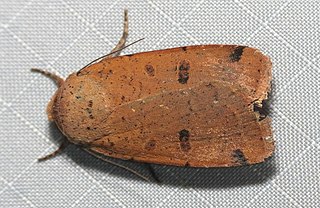
Abagrotis cupida, the Cupid dart or brown climbing cutworm, is a moth of the family Noctuidae. The species was first described by Augustus Radcliffe Grote in 1865. It is found in southern Canada and in the United States east of the Rocky Mountains.
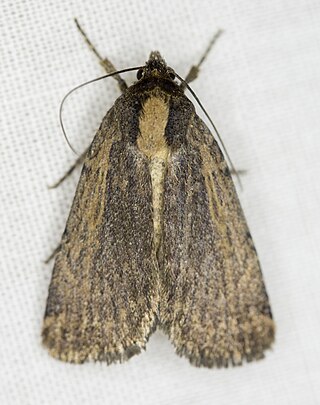
Abagrotis nanalis is a species of moth in the family Noctuidae that was first described by Augustus Radcliffe Grote in 1881. It is found in North America from southern British Columbia east to southwest Saskatchewan and western North Dakota, south to northern New Mexico and California.

Abagrotis orbis, the well-marked cutworm or Barnes' climbing cutworm, is a moth of the family Noctuidae. The species was first described by Augustus Radcliffe Grote in 1876. It is in southwestern North America, extending eastward across the plains and with a large disjunct population in dune habitats in the southern Great Lakes area. It extends into western Canada only in the southern interior of British Columbia and southern Alberta and Saskatchewan.

Agrotis vetusta, the old man dart, spotted-legged cutworm or muted dart is a moth of the family Noctuidae. The species was first described by Francis Walker in 1865. It is found in North America, from southern Alaska to Nova Scotia, southward into Mexico.

Acronicta sperata, the hopeful dagger moth, is a moth of the family Noctuidae. The species was first described by Augustus Radcliffe Grote in 1873. It is found in North America from New Brunswick west to the Alberta foothills, south to the District of Columbia, Missouri and in the mountains to Colorado.

Catocala meskei, or Meske's underwing, is a moth of the family Erebidae. The species was first described by Augustus Radcliffe Grote in 1873. It is found in North America from Maine and Quebec west to southern Alberta and Montana, south to South Carolina in the east and at least Montana in the west.

Actebia squalida is a moth of the family Noctuidae. It known from Finland, the southern Urals, and eastern Siberia.

Actebia fennica, the black army cutworm or Eversmann's rustic, is a moth of the family Noctuidae. The species was first described by August Michael Tauscher in 1806. It has a Holarctic distribution from Newfoundland through western Europe, Siberia, the Far East, Mongolia, northern China to Korea and Japan. In North America it is mainly found in the boreal region, south to New England, southern Montana and northern Oregon.

Alypia ridingsii, the mountain forester or Ridings' forester, is a moth of the family Noctuidae. The species was first described by Augustus Radcliffe Grote in 1864. It is found in North America as far east as the eastern edge of the Rocky Mountains in Colorado. It is also found in Arizona, Utah, all of California and northward into Oregon, Idaho, Washington, British Columbia and Alaska
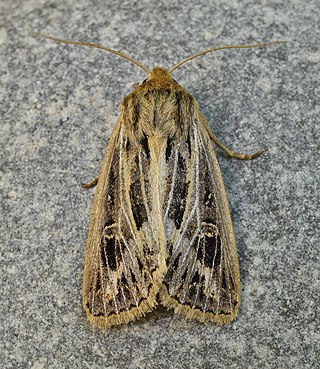
Apamea niveivenosa, the snowy-veined apamea, is a moth of the family Noctuidae. The species was first described by Augustus Radcliffe Grote in 1879. It is native to northern North America, where it can be found across Canada and south to California.

Apamea plutonia, the dusky Quaker or dusky apamea, is a moth of the family Noctuidae. The species was first described by Augustus Radcliffe Grote in 1883. It is native to northern North America, where it occurs across the boreal regions, with some occurrences from as far south as New Mexico and Pennsylvania.

Schinia nuchalis, the spotted sage moth, is a moth of the family Noctuidae. The species was first described by Augustus Radcliffe Grote in 1878. It is found from the Great Plains and Great Basin, from southern Saskatchewan, Alberta and British Columbia south to northern Arizona. The Eurasian Schinia scutosa is no longer considered a synonym of Schinia nuchalis.
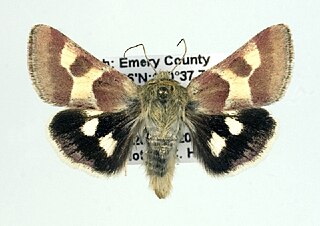
Schinia suetus is a moth of the family Noctuidae first described by Augustus Radcliffe Grote in 1873. It is widespread in the mountains of western North America, from southern Alberta west to British Columbia, south at least to Colorado and California, east to Idaho and New Mexico.

Euxoa cicatricosa is a species of moth in the family Noctuidae that was first described by Augustus Radcliffe Grote and Coleman Townsend Robinson in 1865. It is found in North America from south-central Saskatchewan west to the southern interior of British Columbia; south to southern California, Arizona, New Mexico and western Texas; east to western Nebraska and North Dakota.
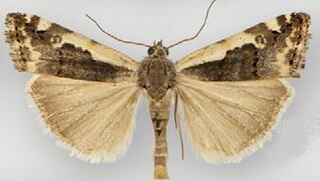
Tarache augustipennis, the narrow-winged midget, is a moth of the family Noctuidae. The species was first described by Augustus Radcliffe Grote in 1875. It is found in North America from Manitoba to south-western British Columbia, south to Arizona and east to Texas.
















